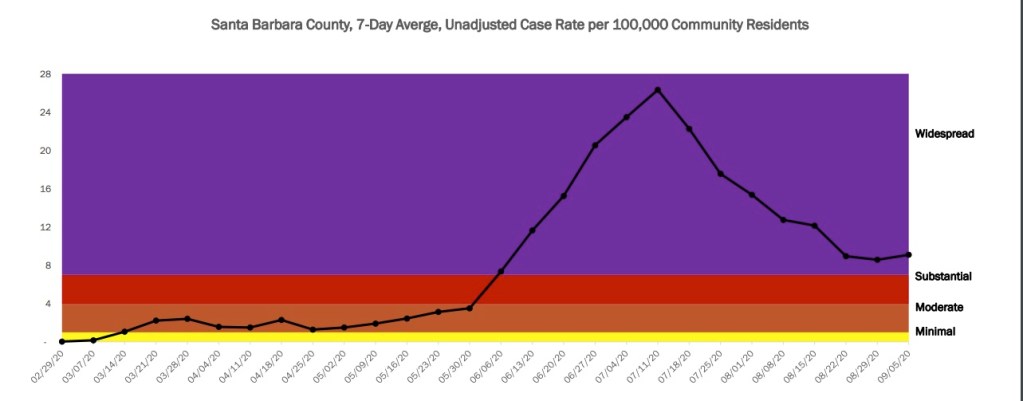Following weeks of consistent declines in COVID-19 hospitalizations and case rates, Santa Barbara County has hit a plateau ― holding business reopenings hostage for now.
Since the state replaced the old metric system with the new, color-coded one, the county has remained in the highest purple tier with the most restrictions. Santa Barbara County’s seven-day average is a little more than eight new cases per 100,000 residents, but the state requires that that number drop to seven or fewer in order for the county to move into the red tier.
“We were trending down dramatically from July 11 until August 22 and have now plateaued just above the red line,” 2nd District Supervisor Gregg Hart said at the Tuesday hearing. “All the things everybody was doing to get us from the very high peak to just above the red line, if we could just do a little bit more. If you’re invited to a gathering, say no; wear your mask all the time outdoors; and wash your hands regularly. If just a few more people did these a little more diligently, we could make it into the red.”
Get the top stories in your inbox by signing up for our daily newsletter, Indy Today.
And Hart was correct: Just a difference of a few cases a day could make the difference between purple and red. Once the county enters the red zone, certain businesses will be allowed to further reopen. That includes restaurants, which are currently only allowed to provide pickup or outdoor dining but would be allowed to offer limited indoor seating, as well, were the county to move into the red tier.
“I want to emphasize that this isn’t just about money, about the thousands of dollars in revenue lost by some business that were barely surviving before COVID,” said Terri Strickland, owner of the Hitching Post steakhouse in Casmalia. Strickland has made several appearances at public comment in recent weeks on behalf of small-business owners in the county who are suffering under the state’s current purple-tier restrictions.
“It’s also about the mental health of the owners,” she said. “I don’t want to downplay the virus, but 162 people [active cases] out of 450,000 ― does anybody else see that it seems we need to be opening up our business? My question today is, what is the date? When will we be able to open up indoors? … I just think you need to tell the governor that these metrics are unattainable.”
But the Public Health Department is confident that the county’s progress is a sign that the county will be able to move into the red tier soon. The department has recently started pushing residents to get tested, regardless of whether or not they’re symptomatic, to try and reduce the metric to seven positive cases per 100,000. There are three state-sponsored testing sites that are free and available to the public in Goleta, Santa Maria, and Buellton. Residents can also get tested by their health-care provider.
What was not discussed at the hearing was the COVID-19 outbreak at the County Jail, which could make or break the county’s chances at moving into the red tier. More than 80 inmates have tested positive inside the jail since the pandemic began ― there were 39 new cases between August 28 and September 4 alone. The Public Defender’s Office has taken the sheriff to court over the outbreak, alleging the conditions are unsafe for inmates. Forty Sheriff’s Office employees have also tested positive.
A handful of public commenters also spoke out about the disproportionate infection rates in people of color and farmworkers in North County. Despite the sharp case decline in Santa Maria, what was once the county’s largest hotspot for the virus, farmworkers in the community are still getting infected by the virus at significantly higher rates.
“If we are ever going to move into the next tier, we need to address more than ever the issue that we have higher rates [of the virus] among lower-income folks,” said 1st District Supervisor Das Williams to Public Health Director Van Do-Reynoso. “But you have been focused on that all summer, so what more can we do?”
Do-Reynoso said her department has been health-equity minded since day one of the pandemic and that Santa Barbara was one of the first counties in the state to stand up a Latinx and Indigenous immigrant task force to work with community partners to address prevention efforts, testing efforts, and treatment efforts in a “culturally and linguistically appropriate manner.”
She also said that the county joined the Housing for the Harvest program, which provides temporary hotel rooms for California farmworkers who have been exposed to or tested positive for COVID-19 but are unable to adequately quarantine at home. Last week, the county also issued a health order requiring temperature screening, self-evaluation, and reporting of COVID-19 cases at all homeless shelters and H-2A housing in the county.
“So we have done quite a bit, but we’re not resting,” Do-Reynoso said. “We continue to explore with our partners what more innovation we can do to decrease the rates.”
As of Tuesday’s hearing, there have been 8,718 positive cases in the county since the pandemic hit. Of those, 162 cases are currently active, and 106 people have died as a result of the virus.
Every day, the staff of the Santa Barbara Independent works hard to sort out truth from rumor and keep you informed of what’s happening across the entire Santa Barbara community. Now there’s a way to directly enable these efforts. Support the Independent by making a direct contribution or with a subscription to Indy+.

